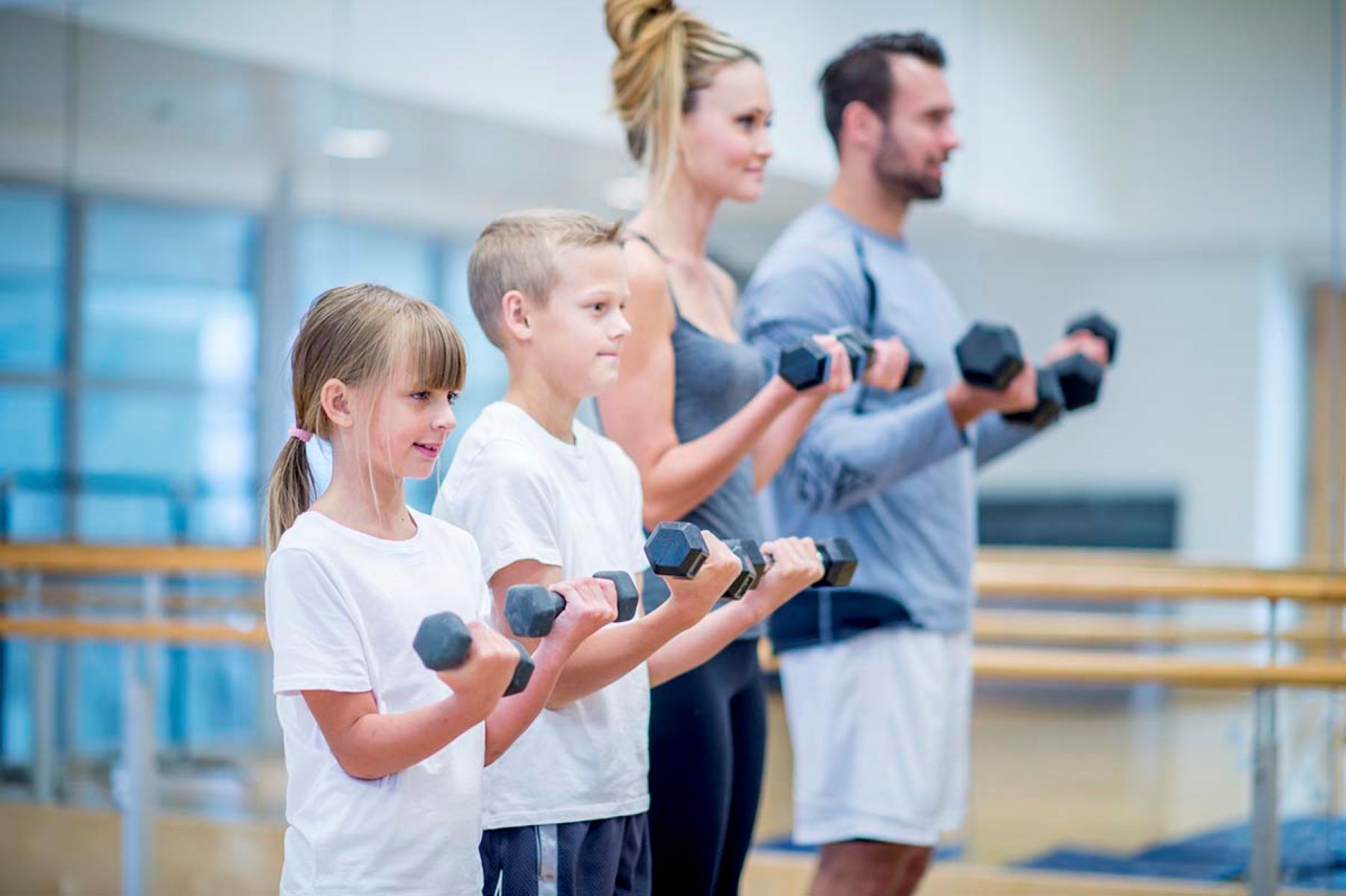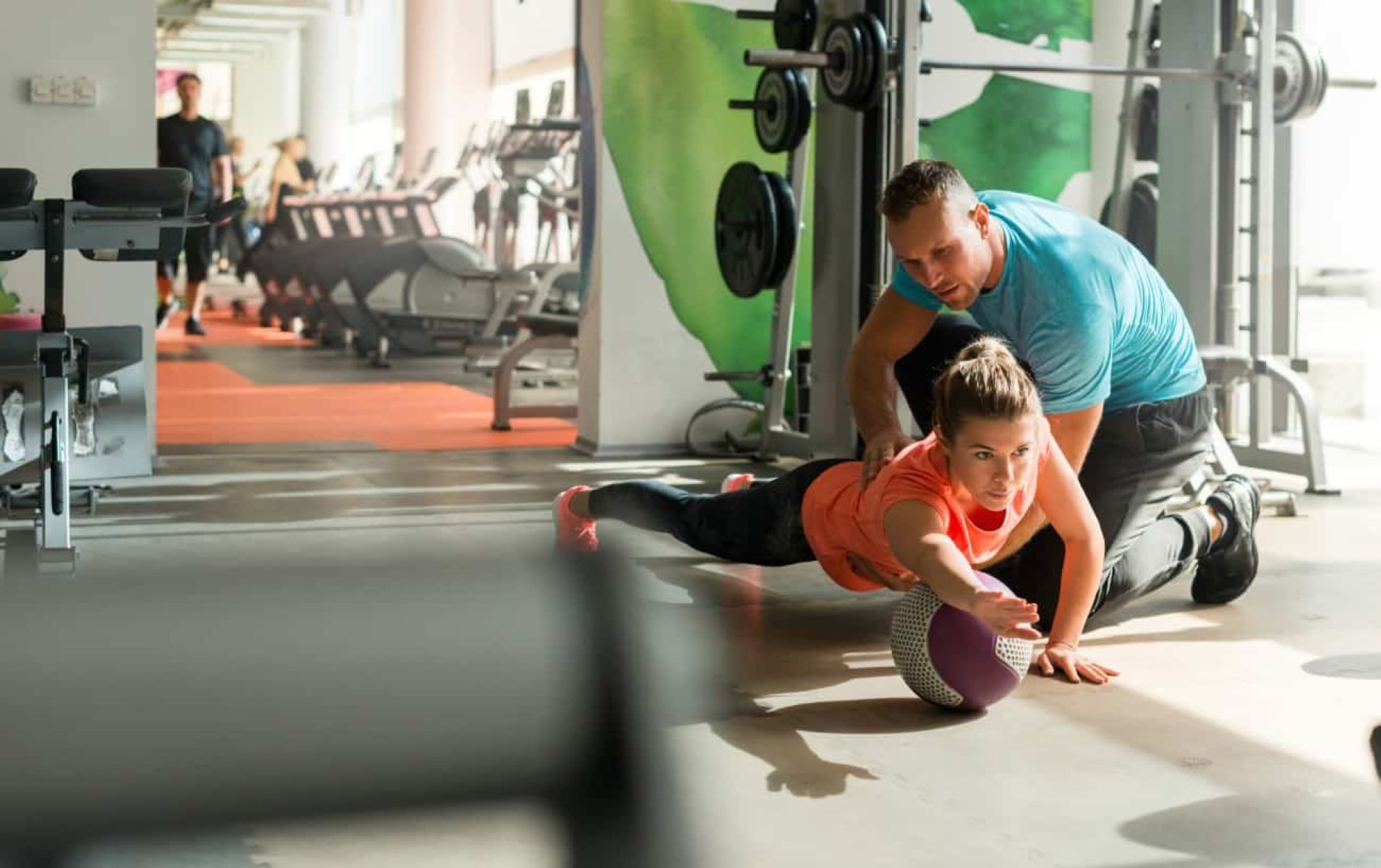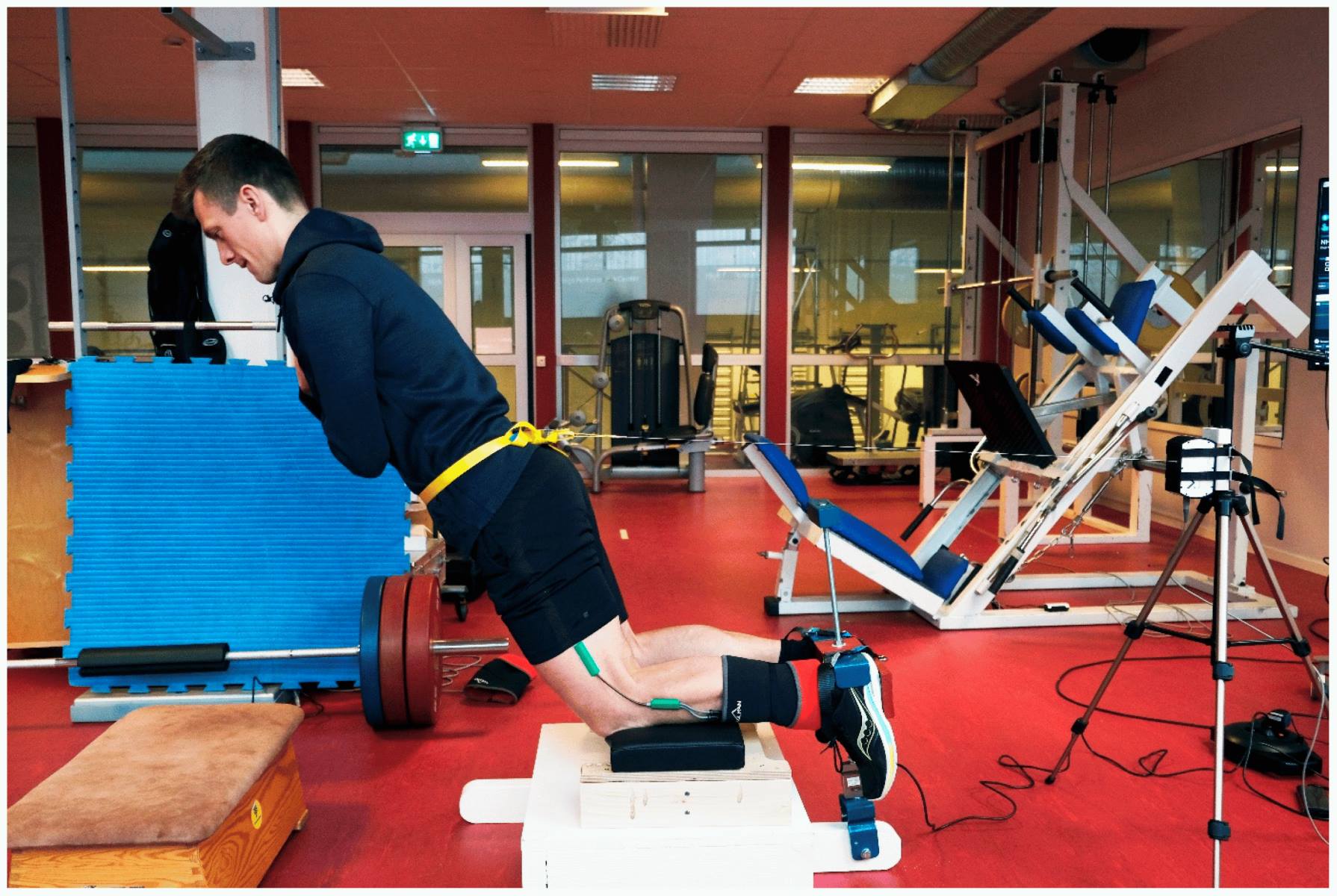Home>Misc>Featured>Which Of The Following Best Describes The Muscular Endurance Component Of Fitness?


Featured
Which Of The Following Best Describes The Muscular Endurance Component Of Fitness?
Modified: March 1, 2024
Enhance your understanding of the essential fitness component - muscular endurance. Discover what best describes it and how it contributes to your overall physical fitness. Featured article.
Introduction
Muscular endurance is a crucial component of fitness that plays a significant role in various physical activities and sports. It refers to the ability of a muscle or a group of muscles to exert force repeatedly over an extended period of time. While many people focus on strength and power, neglecting muscular endurance can limit overall fitness and performance.
When it comes to defining muscular endurance, it is essential to understand that it is different from muscular strength. While strength refers to the maximum force that a muscle or group of muscles can generate, endurance focuses on the muscle’s ability to sustain repetitive contractions or movements.
Muscular endurance is not only important for athletes but also for individuals seeking to improve their overall physical well-being. It plays a crucial role in everyday activities such as carrying groceries, climbing stairs, or even maintaining proper posture throughout the day.
Without adequate muscular endurance, the body may tire quickly, leading to muscle fatigue, decreased performance, and an increased risk of injuries.
In this article, we will explore the definition of muscular endurance, discuss its importance in fitness, highlight its characteristics, delve into the factors that affect it, discuss the benefits of improving muscular endurance, and provide tips on how to enhance this component of fitness.
Definition of Muscular Endurance
Muscular endurance is a fitness component that refers to the ability of a muscle or a group of muscles to perform repeated contractions or movements against a resistance over an extended period of time. It is often measured by the number of repetitions or the duration of time a specific movement can be performed before muscle fatigue sets in.
Unlike muscular strength, which focuses on the maximum force that a muscle can generate, muscular endurance emphasizes the muscle’s ability to sustain repetitive contractions. It is the foundation on which many physical activities, such as endurance running, cycling, or swimming, are based.
When discussing muscular endurance, it is important to consider both localized and general muscular endurance. Localized muscular endurance refers to the endurance of specific muscles or muscle groups, such as the biceps, quadriceps, or core muscles. General muscular endurance, on the other hand, pertains to the endurance of the entire body or multiple muscle groups simultaneously.
Measuring muscular endurance can be done through various methods, including timed exercises, maximum repetitions, or the ability to maintain a specific position or posture. It is essential to note that the specific muscle group or activity being targeted will determine how muscular endurance is assessed.
Improving muscular endurance requires gradually increasing the workload or resistance over time, challenging the muscles to adapt and become more efficient in sustaining prolonged effort. Regular training and progressive overload are key factors in developing and enhancing muscular endurance.
Ultimately, muscular endurance is a crucial component of fitness that supports overall physical performance and helps individuals meet the demands of various activities, whether they be athletic or day-to-day tasks.
Importance of Muscular Endurance in Fitness
Muscular endurance is a critical component of overall fitness and plays a vital role in numerous physical activities and sports. Incorporating muscular endurance training into your fitness routine offers a wide range of benefits.
One key importance of muscular endurance is its ability to enhance stamina and endurance. When your muscles can sustain repetitive contractions over an extended period, you can engage in activities for longer durations without experiencing muscle fatigue. This is particularly advantageous for endurance athletes such as runners, cyclists, swimmers, and long-distance walkers.
In addition to improving stamina, muscular endurance also contributes to improved muscular strength. By training your muscles to endure repeated contractions, you also strengthen them, leading to increased muscle tone and overall strength.
Muscular endurance is also directly related to functional fitness. It improves your ability to perform daily activities such as carrying groceries, lifting objects, or even performing household chores. This translates to improved physical performance and reduced risk of injuries in daily life.
Furthermore, muscular endurance training can have positive effects on body composition. It can help increase lean muscle mass and decrease body fat percentage, creating a leaner and more toned appearance. By incorporating resistance exercises in your workout routine, you can boost your metabolism and burn more calories even at rest, promoting weight management and a healthier body composition.
Another important aspect of muscular endurance is its contribution to postural stability and balance. Strong and enduring muscles provide the necessary support to maintain correct posture, preventing muscular imbalances and reducing the risk of falls or injuries.
Lastly, muscular endurance plays a vital role in injury prevention. When your muscles are strong and capable of enduring prolonged effort, they provide joint stability and protect against common injuries caused by fatigue or inadequate muscle support.
Incorporating exercises that target muscular endurance into your fitness routine is essential for well-rounded fitness and overall health. Whether your goal is to improve physical performance, enhance body composition, or simply lead a healthier lifestyle, muscular endurance training is a valuable component to include in your workouts.
Characteristics of Muscular Endurance
Understanding the characteristics of muscular endurance is essential to grasp the concept fully and effectively incorporate it into your fitness routine. Here are some key characteristics of muscular endurance:
1. Repetitive Contractions: Muscular endurance involves the ability of muscles to perform repeated contractions over an extended period. This means that the muscles can continue contracting without fatiguing quickly.
2. Low to Moderate Intensity: Muscular endurance exercises typically involve low to moderate intensity with a high number of repetitions or an extended duration. This allows the muscles to sustain the effort without reaching exhaustion too soon.
3. Sustained Effort: Muscular endurance requires muscles to work for an extended period without experiencing a significant decline in performance. This sustained effort enables the individual to engage in activities and exercises for longer durations with maintained efficiency.
4. Time Under Tension: Time under tension refers to the amount of time a muscle is under strain during an exercise. Muscular endurance exercises often involve longer durations of continuous effort, focusing on increasing the time under tension to improve endurance capacity.
5. Specificity: Muscular endurance is specific to the muscle group or type of activity being performed. Different muscle groups may have varying levels of endurance, and specific exercises targeting those muscles are necessary for improvement.
6. Delayed Onset Muscle Soreness (DOMS): Muscular endurance training can lead to DOMS, a temporary muscle soreness that occurs within a day or two after exercise. This is a normal response and indicates that the muscles have been challenged and are adapting to the training.
7. Gradual Progression: Developing muscular endurance requires consistent training and a gradual increase in resistance, repetitions, or duration over time. Incrementally increasing the workload challenges the muscles and allows them to adapt and become more enduring.
8. Muscular Balance: Muscular endurance training helps to promote balance and symmetry in muscle development. It ensures that all muscle groups are trained and can endure prolonged efforts, reducing the risk of imbalances and potential injuries.
By understanding and considering these characteristics, you can effectively design your muscular endurance training program and tailor it to your specific goals and needs. Incorporating a variety of exercises targeting different muscle groups and gradually increasing the intensity will help you improve your muscular endurance capacity over time.
Factors Affecting Muscular Endurance
Several factors can influence muscular endurance and impact your ability to sustain repeated contractions over an extended period. Understanding these factors can help you optimize your training and improve your muscular endurance effectively. Here are some key factors that can affect muscular endurance:
1. Muscle Fiber Type: Different individuals have varying distribution of muscle fiber types, namely slow-twitch (Type I) and fast-twitch (Type II) fibers. Slow-twitch fibers are more fatigue-resistant, making them vital for muscular endurance activities. Fast-twitch fibers, while better suited for strength and power, tend to fatigue more quickly.
2. Training Level: An individual’s current training level plays a significant role in muscular endurance. Those who regularly engage in endurance training activities typically have better muscular endurance compared to beginners. Consistent training gradually improves endurance capacity by enhancing the muscle’s ability to endure prolonged efforts.
3. Exercise Selection: The type of exercises you choose for your muscular endurance training can affect its development. Exercises that involve sustained contractions using lighter weights or body weight, such as high-repetition resistance training or circuit training, are ideal for improving muscular endurance.
4. Intensity and Load: The intensity and load of an exercise play a crucial role in muscular endurance development. Training with light to moderate resistance allows for prolonged contractions without reaching fatigue too quickly. It is important to find the right balance between intensity and load to challenge the muscles without compromising form or risking injury.
5. Rest and Recovery: Proper rest and recovery are essential for muscular endurance development. Muscles need time to repair and adapt after a training session. Overtraining or insufficient rest can lead to decreased performance and increased risk of injury. Adequate sleep, nutrition, and rest days are crucial for optimizing muscular endurance.
6. Nutrition and Hydration: Proper nutrition and hydration are key factors in maintaining optimal muscular endurance. Consuming a balanced diet rich in carbohydrates, protein, and healthy fats provides the necessary fuel for prolonged exercise. Staying hydrated ensures optimal muscle function and helps prevent muscle cramps or fatigue.
7. Genetics: Genetics can influence an individual’s baseline level of muscular endurance. Some individuals may naturally possess a higher proportion of slow-twitch fibers, giving them an advantage in endurance activities. However, everyone can improve their muscular endurance through proper training and consistent effort.
8. Age and Gender: Age and gender can also impact muscular endurance. As individuals age, there is a natural decline in muscle mass and strength, which can affect muscular endurance. Additionally, hormonal differences between genders can play a role in endurance capacity. However, consistent training can still improve muscular endurance regardless of age or gender.
Understanding these factors allows you to identify areas for improvement and tailor your training program accordingly. It is important to consider these factors while developing a well-rounded muscular endurance training routine that addresses your specific needs and goals. By doing so, you can effectively enhance your muscular endurance and optimize your overall fitness performance.
Benefits of Improving Muscular Endurance
Improving muscular endurance offers a multitude of benefits that extend beyond just physical fitness. Whether you are an athlete or someone looking to enhance their overall well-being, incorporating exercises that target muscular endurance into your fitness routine can have a positive impact on various aspects of your life. Here are some key benefits of improving muscular endurance:
1. Enhanced Stamina and Endurance: One of the primary benefits of improving muscular endurance is increased stamina and endurance. Your muscles become better equipped to sustain repetitive contractions over an extended period without fatigue. This allows you to engage in activities and exercises for longer durations, whether it be endurance sports or daily tasks.
2. Improved Muscular Strength: Muscular endurance training also leads to improved muscular strength. As muscles become more efficient in enduring prolonged effort, they also become stronger. Increased muscular strength provides a solid foundation for overall physical performance and can enhance performance in strength-related activities.
3. Increased Metabolic Efficiency: Building muscular endurance helps increase metabolic efficiency. Endurance exercises elevate the heart rate and challenge the muscles to work continuously, resulting in increased calorie expenditure. This can aid in weight management and contribute to improved body composition by reducing body fat and increasing lean muscle mass.
4. Enhanced Postural Stability and Balance: Muscular endurance training contributes to improved postural stability and balance. Strong, enduring muscles provide support and stability to maintain correct posture and alignment during daily activities. Enhanced balance reduces the risk of falls and injuries, particularly among older adults.
5. Reduced Risk of Injuries: By improving muscular endurance, you enhance the stability and support around joints, reducing the risk of injuries. Endurance training helps build strong muscles that can withstand prolonged effort, minimizing the likelihood of muscular imbalances, strains, or sprains.
6. Increased Energy Levels: Regularly engaging in muscular endurance exercises can boost your energy levels. Endurance training stimulates the release of endorphins, which are natural mood elevators. It also enhances blood flow and oxygen delivery to the muscles and tissues, leaving you feeling more energized and refreshed.
7. Improved Mental Resilience: Muscular endurance training requires mental focus and resilience. Pushing through the discomfort and fatigue challenges your mental strength, improving your overall mental toughness and discipline. This can have a positive impact on other areas of your life, boosting your confidence and resilience in various situations.
8. Enhanced Cardiovascular Health: Muscular endurance training involves sustained cardiovascular activity, which benefits your heart health. Regular endurance exercises can improve cardiovascular fitness, lower resting heart rate, reduce blood pressure, and enhance overall cardiovascular endurance.
By focusing on improving your muscular endurance, you can experience these wide-ranging benefits. Whether you are an athlete aiming to enhance your performance or an individual seeking overall fitness and well-being, incorporating exercises that target muscular endurance can have a profound and positive impact on your physical and mental health.
How to Improve Muscular Endurance
Improving muscular endurance requires a combination of specific training techniques and a well-designed workout plan. By incorporating the following strategies into your fitness routine, you can effectively enhance your muscular endurance:
1. Perform High-Rep Exercises: Focus on exercises that involve higher repetitions with lighter weights. This helps to build the endurance of your muscles, gradually increasing their ability to sustain prolonged effort.
2. Circuit Training: Circuit training involves performing a series of exercises back-to-back with minimal rest between each exercise. This form of training targets multiple muscle groups, improves cardiovascular fitness, and enhances muscular endurance.
3. Use Isometric Holds: Isometric exercises involve holding a static position, such as a plank or wall sit, for an extended period. Isometric holds increase your muscles’ endurance by maintaining tension over time and challenging their ability to sustain the position.
4. Progressive Overload: Gradually increase the intensity, duration, or resistance of your exercises over time. Progressive overload forces your muscles to adapt and become more enduring, helping to improve your muscular endurance capacity.
5. Include Interval Training: Incorporate interval training into your workouts, alternating between periods of high-intensity exercise and recovery. This method helps to challenge your muscles and cardiovascular system, enhancing both muscular endurance and overall fitness.
6. Balance Cardiovascular Exercises: Include cardiovascular exercises, such as running, swimming, cycling, or rowing, in your routine. These activities improve cardiovascular fitness and help develop endurance in your muscles.
7. Focus on Tempo: Control the tempo of your exercises by emphasizing the eccentric (lowering) phase of the movement. Slowing down the descending phase of an exercise increases the time under tension and further challenges your muscular endurance.
8. Train Multiple Muscle Groups: Utilize compound exercises that engage multiple muscle groups simultaneously. This approach helps improve overall muscle endurance rather than only targeting isolated muscles.
9. Proper Nutrition and Hydration: Ensure you consume an adequate amount of carbohydrates, protein, and healthy fats to fuel your workouts and support muscle recovery. Staying hydrated is also crucial for optimal muscular endurance and performance.
10. Rest and Recovery: Allow sufficient rest and recovery between training sessions. Muscles need time to repair and adapt to the demands placed on them. Adequate sleep and rest days are important for optimizing muscular endurance gains.
Remember, consistency is key when it comes to improving muscular endurance. Aim for regular training sessions that target endurance, gradually increasing the intensity and duration over time. By following these strategies and maintaining a balanced approach, you can effectively improve your muscular endurance and enhance your overall fitness performance.
Sample Exercises for Muscular Endurance Training
When it comes to improving muscular endurance, incorporating specific exercises into your workout routine is essential. These exercises target multiple muscle groups and challenge your muscles to sustain repetitive contractions over an extended period. Here are some sample exercises for muscular endurance training:
1. Bodyweight Squats: Perform sets of bodyweight squats, focusing on maintaining proper form and increasing the number of repetitions with each set. This exercise targets the lower body, particularly the quadriceps, hamstrings, and glutes.
2. Push-Ups: Perform sets of push-ups, aiming to increase the number of repetitions as your muscular endurance improves. This exercise primarily targets the chest, shoulders, and triceps.
3. Plank: Hold a plank position for as long as you can, gradually increasing the duration as you build your core and overall muscular endurance. The plank primarily targets the core muscles, including the abdominals, obliques, and lower back.
4. Lunges: Perform sets of lunges, alternating between legs, and focusing on maintaining proper form throughout. Lunges target the quadriceps, hamstrings, glutes, and calf muscles.
5. Step-ups: Step onto an elevated platform or bench, leading with one foot, and then step down. Alternate between legs and gradually increase the number of repetitions. Step-ups primarily target the quadriceps, hamstrings, and glutes.
6. Bicep Curls: Perform sets of bicep curls using light dumbbells or resistance bands, focusing on maintaining controlled movements and increasing the number of repetitions. Bicep curls target the biceps and forearms.
7. Tricep Dips: Use a bench or elevated surface to perform tricep dips. Aim for higher repetitions and gradually increase the duration of the exercise. Tricep dips primarily target the triceps and shoulders.
8. Plank Rows: Assume a push-up position with dumbbells in each hand. While maintaining a stable core and proper form, alternate rows by pulling one dumbbell up towards your chest. Plank rows engage the core, back muscles, and biceps.
9. Mountain Climbers: Start in a high plank position and alternate bringing your knees towards your chest in a running motion. Aim for a fast-paced movement and gradually increase the duration. Mountain climbers target the core, shoulders, and leg muscles.
10. Jumping Jacks: Perform sets of jumping jacks, focusing on maintaining a steady pace and gradually increasing the number of repetitions. Jumping jacks engage the entire body and provide a cardiovascular element to your muscular endurance training.
Remember to incorporate proper warm-up and cool-down routines, and adjust the intensity and resistance of these exercises based on your fitness level. As you progress, you can add more challenging variations or increase the repetition or duration of each exercise to continue challenging your muscular endurance. It is always beneficial to consult with a fitness professional or trainer to ensure proper form and technique while performing these exercises.
Recommendations for Muscular Endurance Training
To effectively improve your muscular endurance, it is important to follow certain recommendations and guidelines. These recommendations will help you optimize your training and achieve the best results. Here are some key recommendations for muscular endurance training:
1. Start with Proper Warm-Up: Prior to engaging in any endurance training, ensure you warm up properly. This raises your body temperature, increases blood flow to the muscles, and prepares your body for the upcoming exercise. Incorporate dynamic stretches and light aerobic exercises to warm up the muscles and joints.
2. Progress Gradually: When starting a muscular endurance training program, begin with an appropriate level of intensity and gradually progress over time. Start with lighter weights, fewer repetitions, or shorter durations and gradually increase the workload as your muscles adapt and become stronger.
3. Choose a Balanced Approach: Incorporate a variety of exercises that target different muscle groups and movement patterns. This helps ensure muscular balance and prevents overuse injuries. Include exercises for the upper body, lower body, and core muscles in your training routine.
4. Maintain Proper Form: Focus on maintaining proper form and technique during every exercise. This ensures that you are effectively targeting the intended muscles and reduces the risk of injury. If you find it challenging to maintain form, decrease the weight or intensity until you can perform the exercise correctly.
5. Listen to Your Body: Pay attention to how your body feels during exercise. If you experience excessive fatigue or discomfort, modify the exercise or take a break. Pushing beyond your limits can lead to overtraining and increased risk of injury.
6. Include Rest Days: Allow your muscles time to recover and adapt by incorporating rest days into your training program. Rest days promote muscle repair and growth, which is essential for improving muscular endurance. Rest is just as important as the training itself.
7. Progressive Overload: Continuously challenge your muscles by gradually increasing the workload. This can be done by increasing the resistance, increasing the number of repetitions, or extending the duration of your exercises. Progressive overload stimulates muscle adaptation and improvement in muscular endurance.
8. Listen to Your Muscles: Pay attention to how your muscles respond to different exercises and training techniques. If you notice a specific exercise targeting a particular muscle group effectively, incorporate it more frequently into your routine. Likewise, if an exercise causes discomfort or pain, modify or replace it with a similar exercise that feels more comfortable.
9. Stay Consistent: Consistency is key when it comes to muscular endurance training. Aim for regular workouts that target muscular endurance, sticking to a consistent routine over time. This allows your muscles to adapt and develop endurance capacity gradually.
10. Seek Professional Guidance: If you are new to muscular endurance training or have specific fitness goals, consider seeking guidance from a fitness professional or certified trainer. They can help design a customized training program, provide proper instruction on form and technique, and ensure your workouts are safe and effective.
By incorporating these recommendations into your muscular endurance training routine, you can optimize your workouts and achieve the best results. Remember to be patient and consistent, as improving muscular endurance takes time and effort. With dedication and proper training, you can significantly enhance your muscular endurance and overall fitness performance.
Conclusion
Improving muscular endurance is crucial for overall fitness and performance in various physical activities. Muscular endurance refers to the ability of muscles to sustain repeated contractions over an extended period of time. By incorporating specific exercises, gradually increasing intensity, and following the recommended guidelines, you can effectively enhance your muscular endurance.
Developing muscular endurance offers a wide range of benefits, including increased stamina, improved muscular strength, enhanced metabolic efficiency, better postural stability and balance, reduced risk of injuries, increased energy levels, improved mental resilience, and enhanced cardiovascular health.
When training for muscular endurance, it is important to consider factors such as muscle fiber type, training level, exercise selection, intensity, rest, and recovery. By understanding these factors and incorporating proper nutrition and hydration, you can optimize your muscular endurance training.
Sample exercises for muscular endurance training include bodyweight squats, push-ups, planks, lunges, bicep curls, tricep dips, plank rows, mountain climbers, step-ups, and jumping jacks. By performing these exercises with proper form and gradually increasing the workload, you can improve the endurance capacity of your muscles.
Incorporating muscular endurance training into your fitness routine requires consistency, progression, and a balanced approach. It is important to listen to your body, maintain proper form, and allow for rest and recovery to optimize your training and prevent overuse injuries.
Ultimately, improving muscular endurance takes time and effort, but the long-term benefits are worth it. By following the recommendations provided and seeking professional guidance if needed, you can effectively enhance your muscular endurance and achieve your fitness goals. Start incorporating muscular endurance training into your workouts and enjoy the benefits it brings to your overall fitness and well-being.









